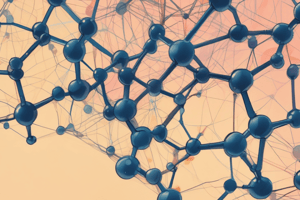Podcast
Questions and Answers
What is the general formula for alkanes?
What is the general formula for alkanes?
- C_nH_{2n-2}
- C_nH_{2n}
- C_nH_{n+2}
- C_nH_{2n+2} (correct)
Alkanes can conduct electricity due to the presence of free moving electrons.
Alkanes can conduct electricity due to the presence of free moving electrons.
False (B)
What is one of the primary processes used to produce smaller alkane molecules?
What is one of the primary processes used to produce smaller alkane molecules?
Cracking
The combustion of alkanes produces _____ and water.
The combustion of alkanes produces _____ and water.
Match the following refinery products with their primary uses:
Match the following refinery products with their primary uses:
Source of alkane?
Source of alkane?
Physical properties of alkane??
Physical properties of alkane??
Alkane chemical properties?
Alkane chemical properties?
How substitution is?
How substitution is?
Definition os substitution
Definition os substitution
Flashcards are hidden until you start studying
Study Notes
Alkane Overview
- Derived from fractional distillation of crude oil, a key source of hydrocarbons.
- General formula: CnH2n+2, indicating saturated hydrocarbons composed of only carbon and hydrogen.
- Characterized by single bonds (C-C) between carbon atoms, making them saturated.
- Typically colorless compounds.
Physical Properties of Alkanes
- Exhibit stronger intermolecular forces due to stable C-C bonds.
- Do not conduct electricity due to the absence of free-moving electrons.
- Melting point (M.P) and boiling point (B.P) decrease with a reduced number of carbon atoms, while increasing as the number of carbon atoms rises.
- Density increases with the number of carbon atoms, affecting molecular size and color, resulting in some alkanes being harder to ignite and having higher viscosity.
Chemical Properties of Alkanes
- Combustion reaction: Alkane + Oxygen → Carbon Dioxide + Water.
- Example reaction: Methane + Oxygen → Carbon Dioxide + 2H2O, illustrating the combustion process.
Refinery Products from Alkanes
- Petroleum gas (C1-C4) and natural gas are light products.
- Gasoline (C5-C12) is used primarily as fuel in vehicles.
- Naphtha serves as a precursor for chemicals and plastics, including plastic bags.
- Kerosene or paraffin is commonly used as jet fuel.
- Diesel is reserved for diesel engine vehicles.
- Fuel oil and lubricating oil (which can produce waxes) are derived from heavier fractions.
- Bitumen is the heaviest residue, utilized in paving and roofing.
Cracking Process
- Involves breaking larger hydrocarbon molecules into smaller, more useful molecules, enhancing the efficiency of fuel production.
Studying That Suits You
Use AI to generate personalized quizzes and flashcards to suit your learning preferences.




